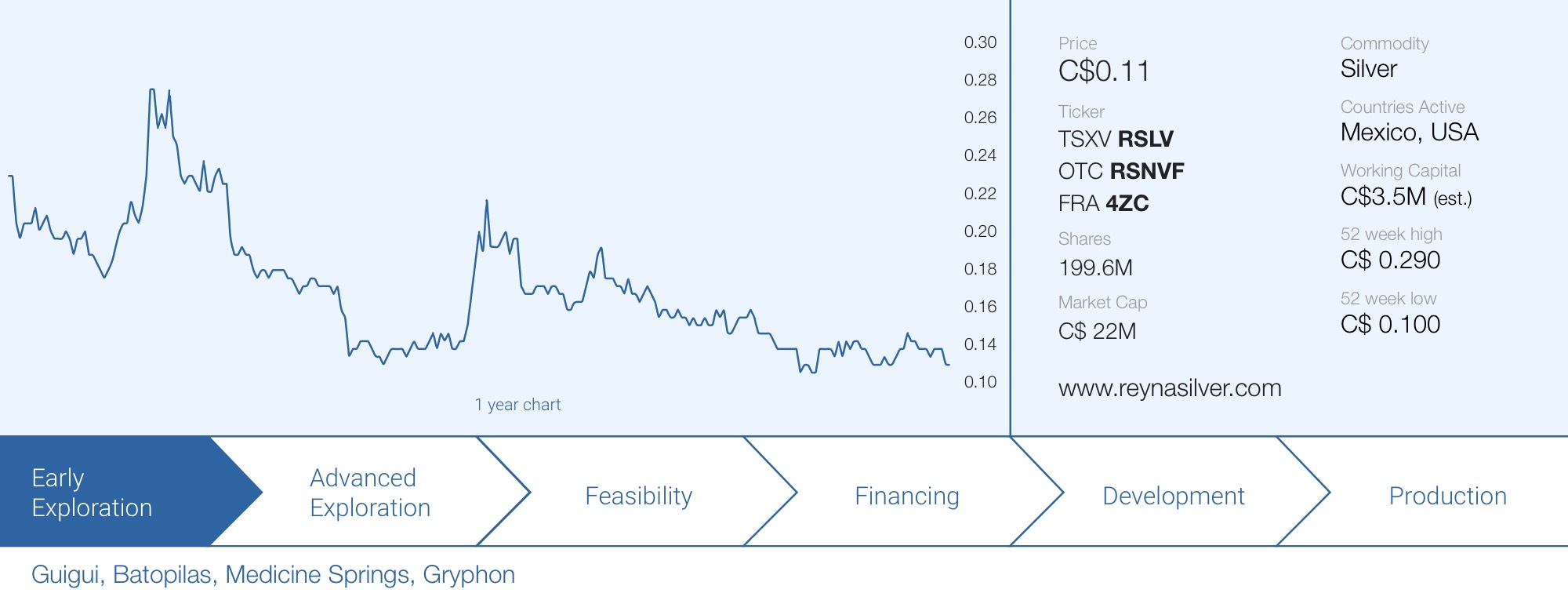
In June, we visited Reyna Silver’s (RSLV.V) operations in Nevada where the company is nailing down the drill targets on its Gryphon and Medicine Springs CRD exploration projects. On this trip, we could pick the brains of Lauren Megaw (recently promoted to VP Corporate Development) and Chief Technical Advisor Peter Megaw. Both are walking encyclopediae on Carbonate Replacement Deposits and were a big help in trying to understand the exploration theory and why the company is excited about these two assets.
While Reyna Silver was originally created to take advantage of the availability of certain Mexican projects, with Guigui as a prominent CRD project and Batopilas providing a high-grade silver and gold angle, it expanded its asset portfolio with two Nevada-based assets where the company is also pursuing its CRD-focused strategy.
As the rhetoric changed leading up to the Mexican presidential elections, Reyna Silver had to rethink its approach. Its two relatively sizeable financings completed in the first and second quarters of the year were meant to support the exploration activities on the US assets while waiting for the dust to settle in Mexico.
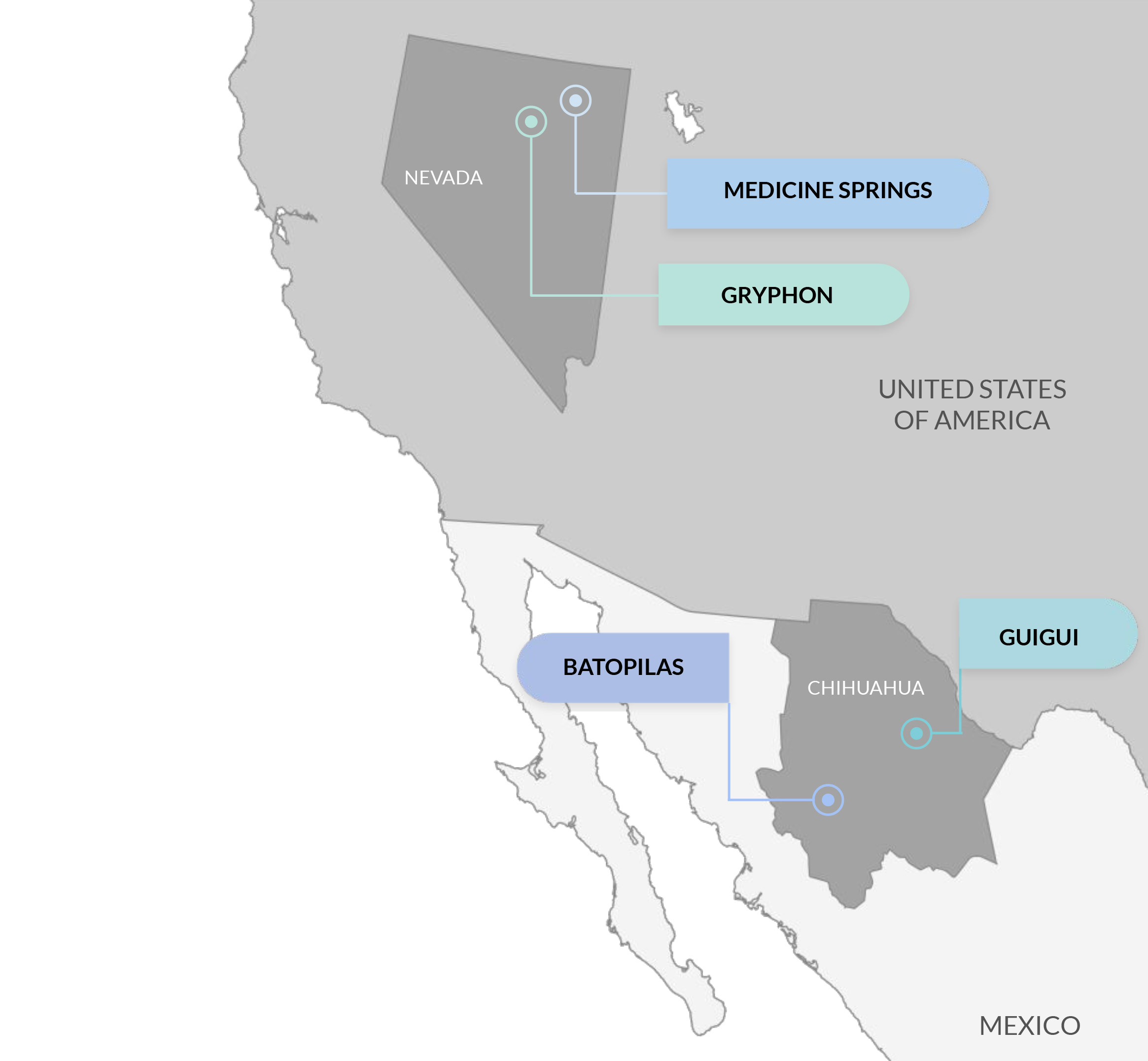
The proposed acquisition of Reyna Gold
Before going into more detail on the properties, the announcement that Reyna Silver will acquire Reyna Gold is important. Right now, both Reynas are in a joint venture to jointly acquire a 70% stake in the Gryphon asset in Nevada. However, Reyna Gold’s balance sheet was pretty weak and combining both companies made the most sense, allowing Reyna Silver – as the surviving party – to obtain 70% ownership in the Gryphon asset. We are not sure what Reyna Silver plans to do with Reyna Gold’s Mexican gold assets, but those are likely of secondary importance to absorbing the rights to the Gryphon project.
It’s perhaps a bit surprising that this is considered an at arm’s length deal given the considerable overlap in the board of directors (four of the six directors of Reyna Gold are also directors at Reyna Silver) but a merger between both Reyna entities likely is the best outcome for all stakeholders. Reyna Gold’s ability to continue as an independent entity was pretty weak given the current state of the junior exploration market.
The terms of the acquisition are straightforward: Reyna Silver is offering one of its own shares for every three shares of Reyna Gold. The acquisition will likely close in October, and we do not anticipate a third party emerging to try to acquire Reyna Gold. That being said, in this report we will still use the ‘Reyna JV’ term to discuss the Gryphon earn-in agreement as the merger/acquisition hasn’t closed yet.
Reyna’s Nevada assets
One of the main advantages of doing business in Nevada is the presence of existing infrastructure and how easy it is to get in and out of the areas Reyna Silver is operating in. Both Gryphon and Medicine Springs are located within an hour drive from Elko, which is a regional mining center. Elko does have an airport with service to Salt Lake City but as there are only two flights per day, one is usually better off just driving from Salt Lake to Elko, a three hour ride on the I-80, a classic two lane Interstate.
Gryphon
Although we first stopped at Medicine Springs, we think it makes sense to start off this site visit report with the day on the Gryphon project. When Reyna originally announced the acquisition of Gryphon (technically ‘Gryphon Summit’) in September of last year, we were skeptical as we weren’t quite sure why a small company wanted to add a fourth project to its already interesting portfolio. We feared the acquisition of Gryphon would distract the exploration team from the other assets.
We were wrong.
The site visit really helped to understand what Reyna Silver’s team sees in the asset, and we now fully understand why the company really wanted to pursue this project.
The 12,058 hectare project (including the Union Hill and Mineral Hill claims that were recently obtained) is located about an hour south of Carlin, another Nevada mining hot spot and the main reason why the most important gold-bearing trend in that part of the state is called the Carlin Trend as you can see open pit gold mines from the main road through town. And that also immediately explains the opportunity for Reyna Silver and Reyna Gold (both companies are currently working in tandem to acquire a joint 70% interest in Gryphon but Reyna Silver will be acquiring Reyna Gold as mentioned earlier in this report) as most previous operators were solely focusing on Carlin-style gold mineralization and completely overlooked the potential for other types of mineralization. This means the CRD potential of the asset was completely overlooked.

And Gryphon is not the sole example of an overlooked CRD-target. Just a little bit further south, I-80 Gold (IAU.TO, IAUG) is re-exploring the Ruby Hill gold mine. A prolific gold producing asset, but the sole reason it was ‘just a precious metals producer was the same narrow-minded thinking pattern so often showcased by majors. Ruby Hill closed as a gold mine after a pit wall collapsed but I-80 Gold went back in with a different approach and recently pulled some excellent base metal intervals out of the ground. With for instance 58 meters containing 13.7% zinc, 0.6% copper and 17.5 g/t silver and 32 meters of 333 g/t silver, 0.6 g/t gold and 27.6% ZnPb, I-80 Gold seems to have a proverbial CRD-elephant by its tail.
And that’s pretty much the same theory Reyna Silver is chasing. Gryphon was only explored for gold while the base metal potential either went unnoticed, or wasn’t cared enough about to be followed up on.












In fact, even the most recent gold-focused drill results from an Agnico Eagle Mines operated drill program indicated obvious gold-heavy zones that were not followed up on. Reyna Silver obtained the data from the 2021-2022 drill program on Gryphon by Agnico Eagle which included an interval of 1.52 metes containing 8.6 meters of gold, starting at a down-hole depth of just 11.4 meters. Not only is that an interesting feature, the location of the hole is perhaps even more interesting. It looks like Agnico Eagle just clipped a high-grade gold structure and although using a different angle of the hole would have allowed Agnico Eagle to pierce the entire mineralized structure (which appears to be 4-6 meters widebut could potentially be wider ), this was never followed up on and Agnico Eagle dropped the project despite encountering gold in nine out of the 12 holes drilled.
As far as we are concerned, re-drilling that known structure appears to be low-hanging fruit to actually drill test the true thickness of the structure as well as its strike length.
While that low-hanging fruit is gold-focused, let’s not forget Gryphon was acquired for its CRD potential. We would recommend you to read our older article from June last year wherein we discussed what CRD systems are, and what the 13 main features of a Carbonate Replacement System are. And lo and behold, Gryphon already checks the majority of the boxes. As you can see below, 8 of the 13 boxes have been checked, and that is pretty much before Reyna Silver did any ‘real’ work on the property.
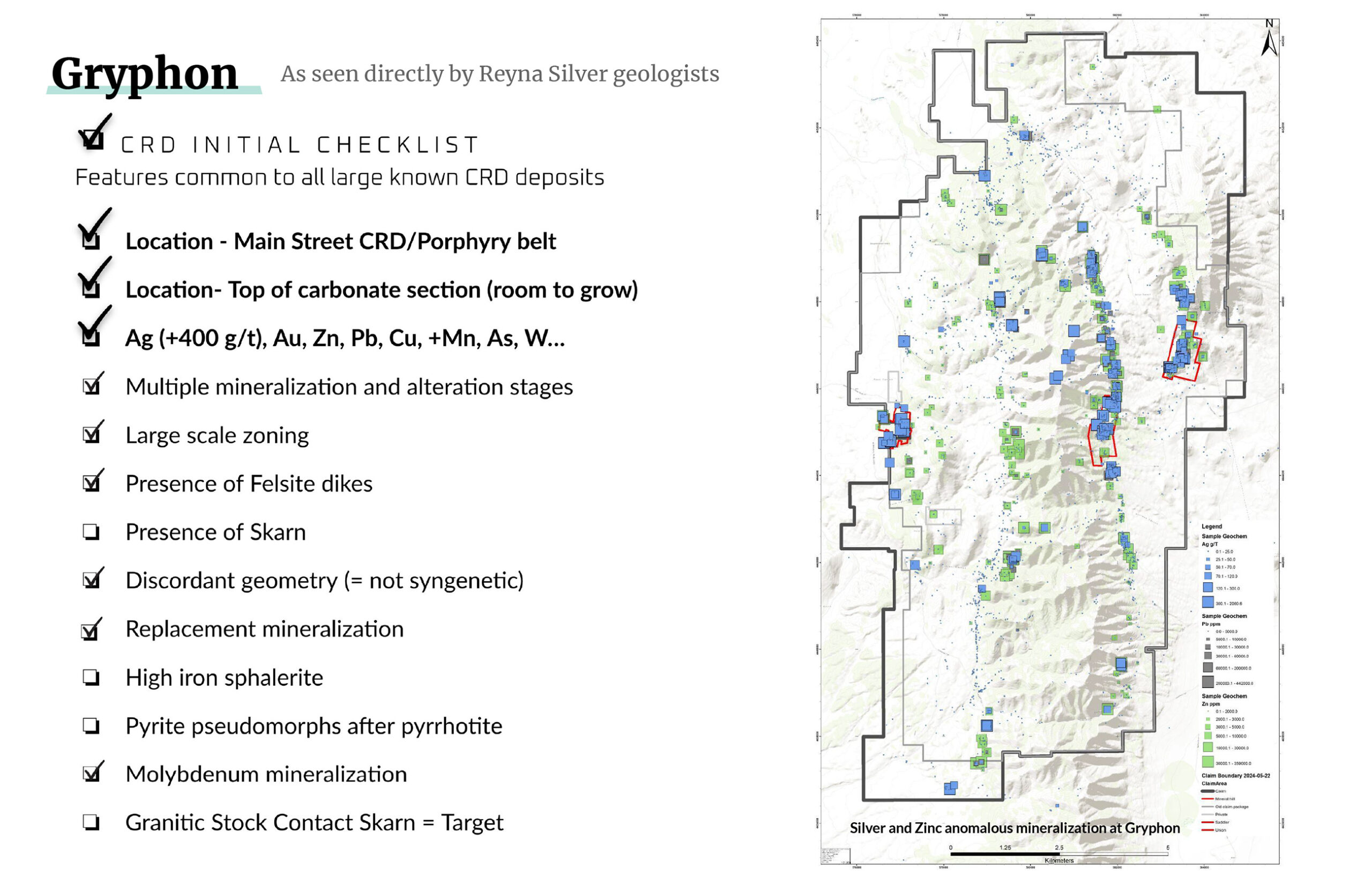
In fact, the property doesn’t have just CRD (and gold) potential, the company highlights the so-called ‘trifecta potential’ at Gryphon. There is the Carlin-style gold mineralization (in the Pogonip Group rock and Vinini Formation) and CRD mineralization (in thelimestone units), but there also is potential to find nickel and copper as additional metals as two main mineralization events appear to be co-mingled at Gryphon.
That’s not just a pipe dream. Previous operators have sampled gold grades up to 24 g/t gold, silver grades of up to in excess of 2,000 g/t, zinc grades of up to 35%, copper grades up to 11.6% and some nickel as well. Of course these ‘up to’ grades have no meaning other than showing how highly anomalous the metal values are in some areas of the deposit and how it is definitely warranted to follow up on those.
Seeing and now understanding the potential of Gryphon, we now understand why Reyna Silver pursued this project. And hopefully the first time this project is explored for its CRD potential will yield the desired results.
As a reminder, the acquisition terms of Gryphon are quite straightforward. Reyna Silver actually teamed up with Reyna Gold to acquire 70% of the project in a 50/50 joint venture. Both companies need to spend US$9.5M on exploration by the end of April 2027 as well as making US$1.1M in cash payments before October 2026 and issue 1.2 million Reyna Silver and Reyna Gold shares by April 2027. Reyna Silver and Reyna Gold are supposed to split the required expenditures on a 50/50 basis, but as Reyna Silver will close the acquisition of Reyna Gold in the next few weeks or months, the burden will fall onto RSLV.
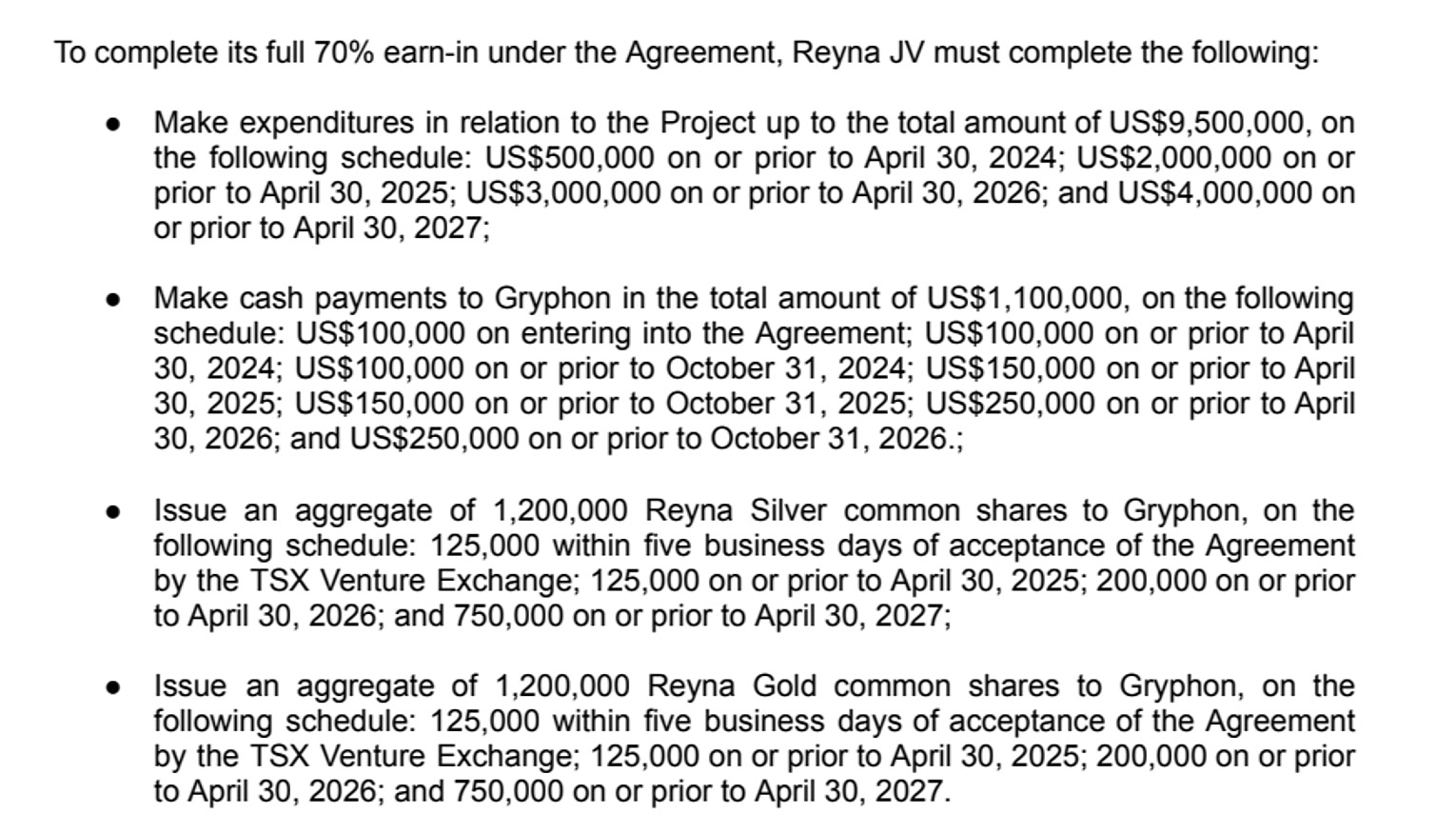
As the table above shows, the Reyna JV is required to spend US$2.5M by the end of April next year (US$2M to be spent between April 2024 and April 2025). As of the end of June , the Reyna JV over C$1.5M.
Upon completing the earn-in, Reyna Silver will own 70% of the asset with the private partner owning a residual interest of 30%. Additionally, the seller will be granted a 2% NSR (but the Reyna Silver will be able to buy back half of that issued NSR).
In August, the company announced it had entered into an option agreement with AuLode LLC on the Union Hill project, which is surrounded by the ‘original’ Gryphon land package. The patented claim group consists of 81 hectares and comes right after the acquisition of the Mineral Hill land package, and could be seen as the ‘missing link’ to consolidate the area. The company will now use the geometry and geochemistry of the historical CRD workings at Union Hill and Mineral Hill to vector towards the underlying sulphide mineralization.












Medicine Springs
Although the main purpose of the trip was to get a better understanding of the Gryphon project, we also spent a few hours with VP Corporate Development Lauren Megaw on the Medicine Springs project which is a bit further east from Gryphon and quite conveniently located close to the highway connecting Salt Lake City and Elko.
Medicine Springs was the first project Reyna Silver took on in Nevada. Previous owners were focusing hard on the silver component of the mineralization. Historically, that makes sense. Silver was more valuable than the base metals that were found at Medicine Springs, but it’s exactly that combination of silver-lead-zinc that further strengthened the thesis Medicine Springs should be seen as a CRD project.







We visited the Golden Pipe area as that is the area of the Medicine Springs project that hosted most of the exploration (and mining) activities, with the shaft remaining as a silent witness of the small tonnages of silver, lead and zinc that were produced from a small underground manto-focused operation. There’s plenty of historical assay data available, even going back to the USMX drill program in the 1980s, which already intersected near-surface CRD-like mineralization with, for instance, 9.2 meters containing almost 42 g/t silver and close to 4.5% ZnPb.
Other operators continued to drill the Golden Pipe are and intersected pretty interesting intervals such as almost 17 meters of 68 g/t silver and 7.16% ZnPb, and 6.1 meters containing 185 g/t silver and 4.07% ZnPb. Encountering these metals and at those grades helped to tick an important box in the CRD checklist. And as you can see below, 11 out of the 13 boxes have been ticked so far.
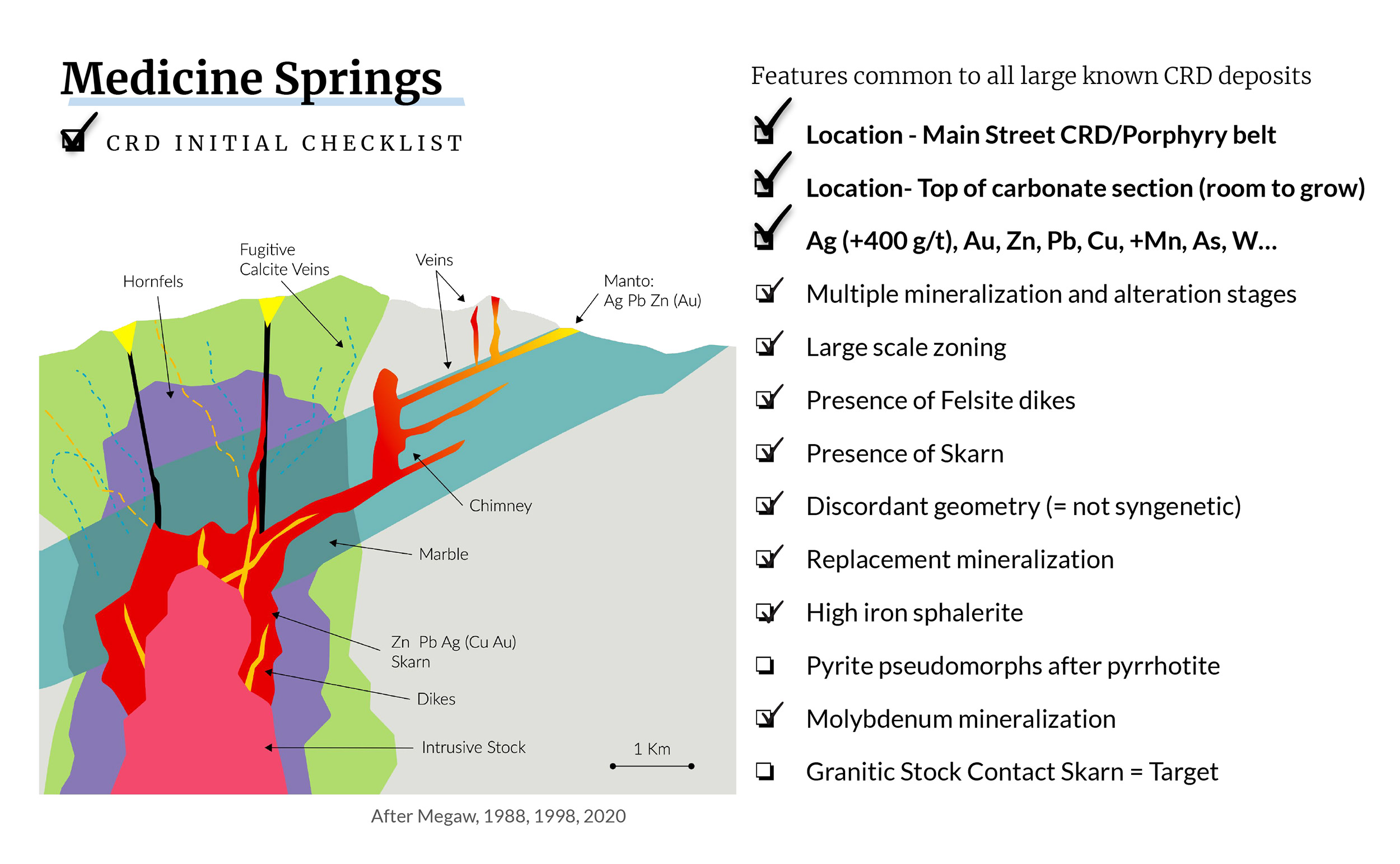
And Reyna Silver completed some drill holes at Medicine Springs (with the assay results shown below).
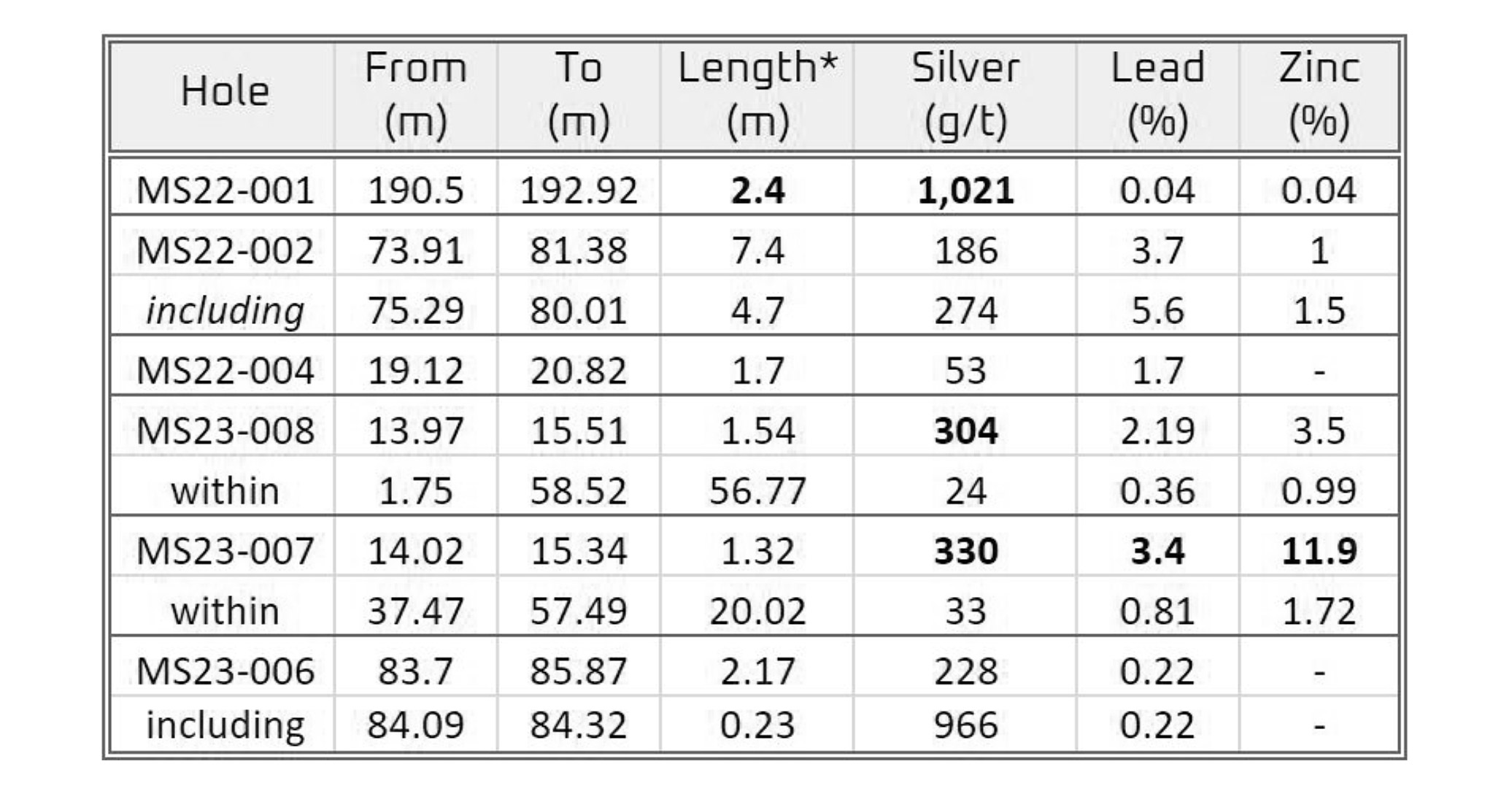
So while the grades were already getting pretty interesting, there is one other element that warrants some attention: the location of the drill holes. As the map below shows, the drill results line up nicely with the interpretation of the geochemical zonation, confirming the exploration theory makes sense.
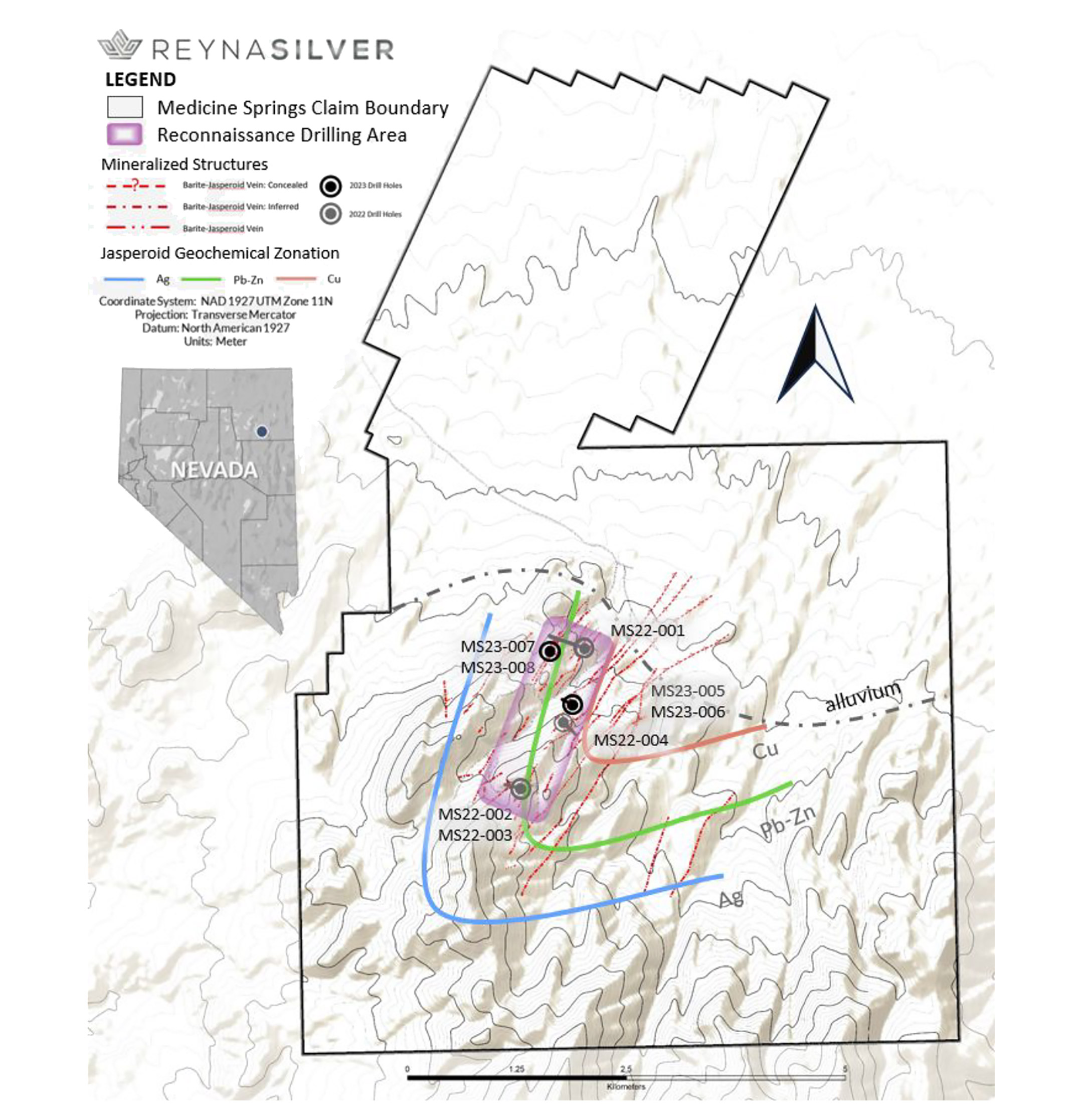
We think Medicine Springs will be put on the backburner for a bit, and that makes total sense given the recent developments at Gryphon. The company renegotiated the terms to acquire full ownership of Medicine Springs earlier this year, so there is no sword of Damocles hanging over its head if it doesn’t do any additional work.
To acquire full ownership, the company has to make mandatory payments of US$525,000 in cash between now and October 2025) and issue US$300,000 in Reyna Silver stock. We don’t anticipate any difficulties and expect Reyna Silver to be the sole owner of Medicine Springs before the end of next year.






The recent capital raise
Earlier this year, the company raised cash on two separate occasions. Most recently, in May, the company issued 11.1 million units at C$0.16 per unit for total proceeds of C$1.77M. Each unit consisted of one common share and a full arrant allowing the warrant holder to acquire an additional share for C$0.24 during a 24 month period.
That second financing came pretty shortly after closing a C$4.6M raise in March of this year. That financing was priced at C$0.12 an contained a full warrant with an exercise price of C$0.20, for a period of 36 months.
The company recently published its Q2 results, and it ended the second quarter with a positive working capital position of approximately C$3.5M. We do not expect a meaningful contribution from Reyna Gold after the merger closed. Although Reyna Gold had a positive working capital position of C$0.55M at the end of Q1, the company will have spent more cash while the legal fees related to the acquisition will likely drain the remainder of the Reyna Gold treasury.
Conclusion
Reyna Silver is clearly positioning itself as the premier CRD-focused exploration company. The recently announced acquisition of Reyna Gold will consolidate the future ownership of the Gryphon project in Nevada as Reyna is working its way towards a 70% ownership in the project.
It’s still pretty tough out there for non-revenue exploration companies and with almost half a dozen interesting exploration assets, Reyna Silver will for sure have to make choices while cash remains scarce. And that’s fine. It is clear the main focus is now on the Gryphon project as the company’s technical team feels the asset has what it needs to be a company maker.
We are looking forward to seeing the assay results from the drill program at Union Hill as that will already provide plenty of data to figure out the next steps.
Disclosure: the author has a small long position in Reyna Silver. Reyna is not a sponsor of the website. We expect to be reimbursed for the majority of our travel expenses. Please read our disclaimer.
